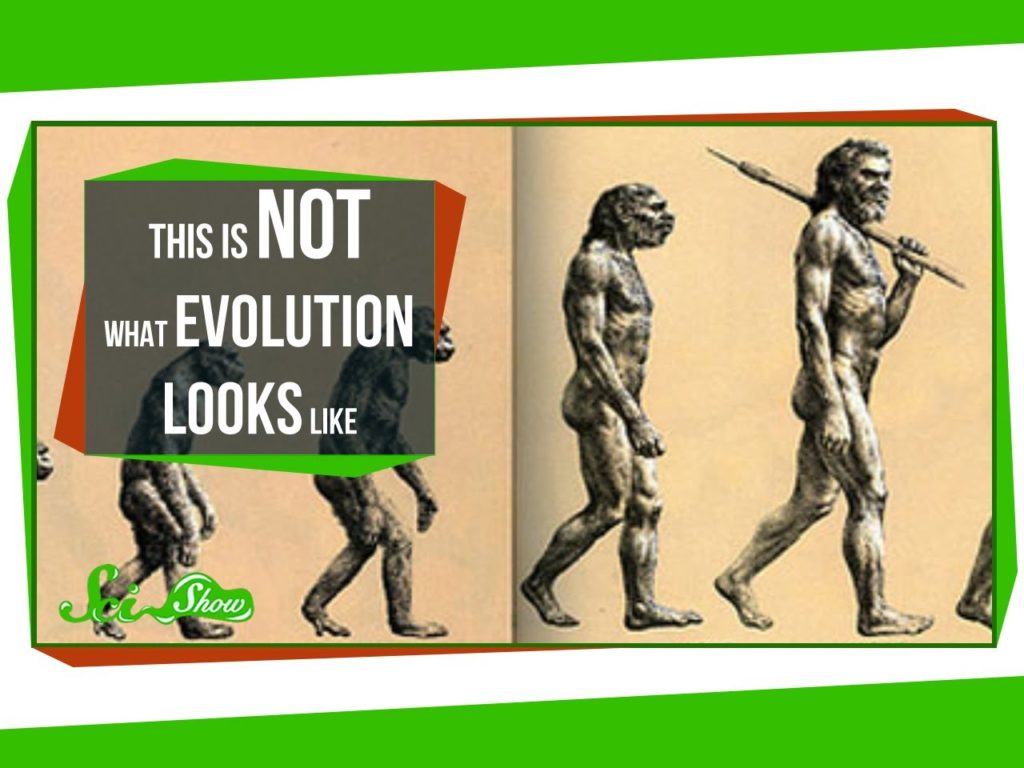This is NOT What Evolution Looks Like

Along with the double helix and the famous Blue Marble photo of the Earth taken from space, it’s probably one of the most recognizable scientific images in the world: a depiction of human evolution in just 6 easy steps. But of course, as professional wrestling and pretty much all of reality television has shown us, just because something is popular doesn’t mean that it’s an accurate depiction of reality. Let me walk you through it: You probably recognize the naked guy on the right; that’s Homo sapiens, an anatomically modern human. The guy who seems to be stalking him is labeled “Cro-magnon,” a rough-looking customer who I’ll talk about more in a minute. Behind him is Neanderthal. On his heels are Ramepithecus, then, Oreopithecus (which sounds delicious), and finally, a tiny, monkey-like early ape known as Dryopithecus.
The idea of this evolving from this may seem like it’s right out of the 19th century, but these images actually first appeared in 1965 in a volume published by Time Life books, called “Early Man.” And, in its defense, the book wasn’t exactly trying to say that we evolved right from that hairy little homunculus. Instead, the book, written by anthropologist F. Clark Howell, offered a relatively nuanced discussion of human evolution for the time, and it even warned against interpreting the illustration literally as a progression from one species directly to the next. But, the book sold well, and the illustration became extremely popular.
And, even though the picture originally included 15 different primates in a row and was called the “Road to Homo Sapiens,” the abbreviated version of it became known as “The March of Progress.” And, thus, one of science’s most pernicious memes was born. So, what’s wrong with this picture? Well, first of all, there are only males in this picture. Humans, like most animals, reproduce sexually, which means we come in two distinct flavors that make our existence possible. Teaching the history of our development with only one sex is like trying to eat sushi with only one chopstick— you’re just not gonna get it all. Next, we’re not even directly related to some of those guys Like, as Howell himself pointed out: Oreopithecus was kind of a bit player in the human drama It lived for a few million years in what’s now southern Europe, but disappeared rather quickly. And the latest research suggests that it probably wasn’t even bipedal, as you see here.
Then, there’s Cro-magnon. While that was kind of a catch-all phrase for “primitive humans” fifty years ago, the specimen that the term was based on turned out to be a modern Homo Sapien. So, they’re generally no longer considered to even be a thing. We also did not evolve from Neanderthals, as the picture suggests. Modern humans and Neanderthals actually co-existed until about 40,000 years ago. We were contemporaries, with a shared common ancestor. But they turned out to be unable to adapt to all of the changes in the world around them, including the arrival of us. And that’s by far the most important problem with this image: evolution isn’t a linear process. It doesn’t turn one species into another into another. It’s really about genetics. Organisms are constantly developing new adaptations and the ones with the adaptations that make them most fit for their environment end up reproducing more and spreading their genes all over the place.
Scientists call that being “evolutionarily successful,” and there are plenty of other organisms with whom we share ancestors that are just as successful, like chimps and orangutans, because they continue to exist and evolve like we do. If you had to express it visually, the human story probably would look more like an incredibly complex tree, or maybe more of a fractal, with many stubs and branches, some of which extend to the present time while others taper out. But it definitely would not resemble some kind of primate police lineup.






Responses